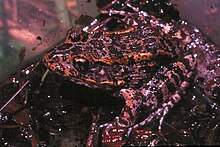| Gopher frog | |
|---|---|

| |
|
Scientific classification
| |
| Domain: | Eukaryota |
| Kingdom: | Animalia |
| Phylum: | Chordata |
| Class: | Amphibia |
| Order: | Anura |
| Family: | Ranidae |
| Genus: | Lithobates |
| Species: | L. capito
|
| Binomial name | |
| Lithobates capito
Le Conte, 1855
| |
| Synonyms | |
| |
The gopher frog (Lithobates capito) [2] is a species of frog in the family Ranidae, endemic to the south-eastern United States. It primarily inhabits the threatened sandhill communities, flatwoods, and scrub in the Atlantic coastal plain, [3] where it is usually found near ponds. [4]
Subspecies
Its two subspecies include the Carolina gopher frog (L. c. capito), and Florida gopher frog (L. c. aesopus). The dusky gopher frog (L. sevosus), also known as the Mississippi gopher frog, had previously been considered a subspecies, but was elevated to species status in 2001. [5]
Range
Gopher frogs occur along the Atlantic seaboard of the United States from southern North Carolina to peninsular Florida. The gopher frog's range extends west along the Gulf Coast to the Tombigbee River in Alabama. The Florida gopher frog is restricted to peninsular Florida. [1] Today, gopher frogs' distribution is patchy, owing greatly to loss of longleaf pine forest communities. [1]
Ecology
Within the flatwoods, xeric longleaf pine– turkey oak communities, sand pine scrub and oak hammocks they call home, gopher frogs move between mass breeding sites in ephemeral or semi-permanent wetlands and summer upland habitat. In these non-breeding times, gopher frogs frequently inhabit gopher tortoise burrows, [1] as well as the tunnels of burrowing crayfish [4] or rodents, [1] or holes associated with felled longleaf pine trees as has been observed in North Carolina. [6] Migration out of the breeding habitats typically occurs at night when it is raining, [1] and frogs have been recorded moving up to 3.5 kilometres (2.2 mi) into their summer refugia. While en route in migrations through mid-May, gopher frogs may be vulnerable to mortality associated with prescribed burns and predation. [6]
Conservation status
Gopher frogs' primary threats include loss of habitat and fire suppression. It is entirely dependent upon small vernal pools for its annual reproduction. [7] These pools in pine flatwoods are being lost to development, and to fire suppression, which allows forests to invade the natural savanna habitat. Hence, prescribed burns and habitat acquisition are considered key management strategies for its survival. [8]
Footnotes
- ^ a b c d e f IUCN SSC Amphibian Specialist Group (2022). "Lithobates capito". IUCN Red List of Threatened Species. 2022: e.T58564A118981594. Retrieved 22 December 2022.
- ^ Frost, Darrel (2011). "American Museum of Natural History: Amphibian Species of the World 5.5, an Online Reference". Herpetology. The American Museum of Natural History. Retrieved 2013-02-17.
- ^ United States Geological Survey. "Rana capito". Retrieved 2007-09-04.
- ^ a b Georgia Museum of Natural History. "Gopher Frog (Rana capito)". Archived from the original on October 18, 2006. Retrieved 2007-09-04.
- ^ Stephen C. Richter and Rebecca A. Doubledee (2001). "Rana sevosa". AmphibiaWeb. Retrieved 2008-08-05.
- ^ a b Humphries, W. Jeffrey; Sisson, Michael A. (2012). "Long Distance Migrations, Landscape Use, and Vulnerability to Prescribed Fire of the Gopher Frog (Lithobates capito)". Journal of Herpetology. 46 (4): 665–670. doi: 10.1670/11-124.
- ^ Richter, S. C., Young, J. E., Johnson, G. N., and Seigel, R. A. (2003). Stochastic variation in reproductive success of a rare frog, Rana sevosa: implications for conservation and for monitoring amphibian populations. Biological Conservation 111: 171–7.
- ^ Florida Natural Areas Inventory (2001). "Gopher Frog (Rana capito)" (PDF). Field Guide to the Rare Animals of Florida. Archived from the original (PDF) on 2007-09-27. Retrieved 2007-09-04.
References
- Hillis, D.M., Frost, J.S.,& Wright, D.A. (1983): Phylogeny and biogeography of the Rana pipiens complex: A biochemical evaluation. Systematic Zoology' 32: 132–143.
- Hillis, D.M. (1988): Systematics of the Rana pipiens complex: Puzzle and paradigm. Annual Review of Systematics and Ecology 19: 39–63.
- Hillis, D.M. & Wilcox, T.P. (2005): Phylogeny of the New World true frogs (Rana). Mol. Phylogenet. Evol. 34(2): 299–314. doi: 10.1016/j.ympev.2004.10.007 PMID 15619443 PDF fulltext.
- Hillis, D. M. (2007) Constraints in naming parts of the Tree of Life. Mol. Phylogenet. Evol. 42: 331–338.
External links
- Gopher Frogs, Burrows, and Fire: Interactions in the Longleaf Pine Ecosystem - 2009 University of Florida Fact Sheet
- Rana capito in the CalPhotos photo database, University of California, Berkeley
